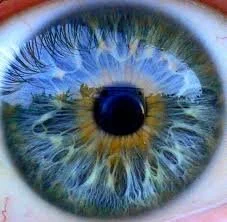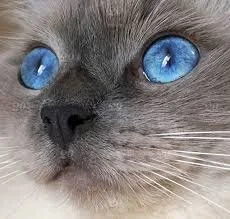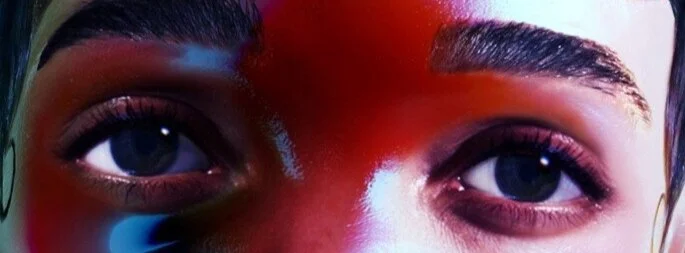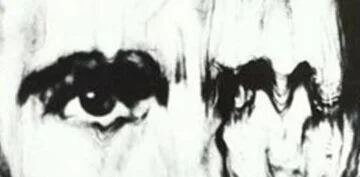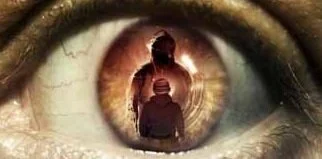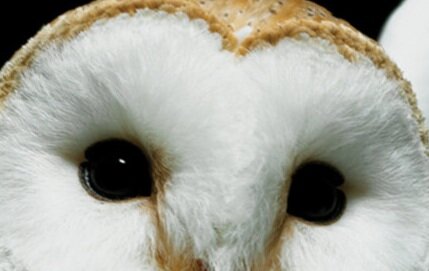By The Landlord
“Love looks not with the eyes, but with the mind,
And therefore is winged Cupid painted blind.” – William Shakespeare
“The eye is the jewel of the body.” – Henry David Thoreau
“The sky is the daily bread of the eyes.” – Ralph Waldo Emerson
“Just because a man lacks the use of his eyes doesn't mean he lacks vision.” – Stevie Wonder
“Open your eyes, look within. Are you satisfied with the life you're living?” – Bob Marley
“Who are you going to believe, me or your own eyes?” – Groucho Marx
What are we seeing here? They are a visionary miracle of evolution, these rolling, roving, winking, blinking self-adjusting infinity engines of perceptive expressivity. But how did it all start? When some rogue unicellular organism, slowly becoming mutant stem mollusk somewhere in the Ediacaran period, around 650 million years ago, accidentally developed a strange spot with a sensitivity to light? And then, this happy accident, this squinting crack of a miracle, gradually gazed out and morphed into a globe of photoreceptor cells with rods and cones, optical nerve, lens, retina, cornea, pupil, iris, vitreous humour and more, bringing binocular, colour, depth field and more, and everything that does to the brain.
But for a song topic, this is less about the science, more about a two-way process – what the eye perceives and how it is seen, the grand metaphor of how those things can be so at odds. Do you see, and therefore feel, what I do? Will you still love me tomorrow? What mysteries lie in those dark pools of black, green, grey, blue or brown? All that of course can all change with the blink of a eye, a sly swivel, a fresh sheen of moisture, a glint of light, just one look outwards or inwards, one of uncertainty, fear, joy, relief, vulnerability, ruthlessness, deception, jealousy, realisation. All is contained in those flecked, tiny oceans indicating survival, constantly in flux, adjusting, glancing, thinking, feeling.
Ole’ blue eyes …
But human eyes, using the refractive cornea enjoyed by most mammals, birds, even reptiles, are just one type. There are many, evolved for environments and diets. Pit eyes, also known as stemma, allow a different perception of light, as used by pit vipers who can sense thermal infra-red radiation. And then there are spherical lens eyes, mirror eyes ones with multiple lenses, mirror and the many types of compound eyes used by insects, all evolved to different lives and environments. The whole of life is reflected, in more than one way, via these extraordinary liquid solids. As the philosopher Martin Buber put it: “An animal's eyes have the power to speak a great language.”
The eyes have it, from all forms of life …
In their function, human eyes are decent all-rounders, with especially good depth and colour perception. We're less good at other things such as seeing fast-moving objects, night sight, or all-round angle vision. At best we can see a field of 180 degrees. Most birds can far more at a glance, goats can see 300 degrees all the time, and many insects can see a full 360 degrees, which is why they are so hard to swat. And stalk-eyed flies have their eyes, well obviously on stalks, projecting from their heads. Sharks have extraordinary vision in low light. Geckos have night vision 300 times better than humans) pinholes in their pupils which can adjust to light levels. But perhaps most otherworldly of all optical creatures is the peacock mantis shrimp, which has the ability to see circularly polarised light, perceiving the world in a very different way to us.
Swivel vision with wavelength perception: peacock mantis shrimp
Some eyes are warm and loving, others are cruel. “No one knows what it's like / To be the bad man / To be the sad man / Behind blue eyes,” that famous line by Pete Townshend, could be applied to a wolf, a cat, or another animal, as much as a person.
Our eyes play with our brains. There are well-known graphic optical illusions with faces and vases and so on, but perhaps more fun are when objects or people randomly move into position to fool our perception. Here are a couple of examples.
Floating bin?
Mystery biker girlfriend?
In the bar, as usual, we have a host of regulars and others eager to tell us more about eyes and their relationship to the brain. Usually when they are out of sync. Can we really believe our eyes. Not always.
“Few are those who see with their own eyes and feel with their own hearts,” says Albert Einstein.
“A lover's eyes will gaze an eagle blind,” adds William Shakespeare.
“You can't depend on your eyes when your imagination is out of focus,” adjusts Mark Twain.
“Weak eyes are fondest of glittering objects,” moans Thomas Carlyle
“The eyes of others our prisons; their thoughts our cages,” adds Virginia Woolf.
“The hardest thing to see is what is in front of your eyes,” says Johann Wolfgang von Goethe.
“There are various eyes. Even the Sphinx has eyes: and as a result there are various truths, and as a result there is no truth,” sums up Friedrich Nietzsche.
And adding a whole other dimension, “But O, how bitter a thing it is to look into happiness through another man's eyes,” says Shakespeare.
Horse, of course.
Many great artists regard an inner vision as more valuable that relying solely what eyes perceive. “To draw you must close your eyes and sing,” says Pablo Picasso. And Salvador Dali saw those limits in people’s addiction to TV: “What is a television apparatus to man, who has only to shut his eyes to see the most inaccessible regions of the seen and the never seen, who has only to imagine in order to pierce through walls and cause all the planetary Baghdads of his dreams to rise from the dust.” What an image.
Eagle owl
And yet eyes also give out, and feed back more information than we realise. “The eyes have one language everywhere,” says George Herbert.
It is only when light is reduced that the pupil opens and feeling goes out of the eyes like touch. says the artist James Turrell, whose installations play with the very sky and a series of changing colours.
“Where words are restrained, the eyes often talk a great deal,” says the pioneering novelist Samuel Richardson.
““Poets are damned… but see with the eyes of angels,” says are rather stimulated Allen Ginsberg.
“The face is a picture of the mind with the eyes as its interpreter,” says Marcus Tullius Cicero.
“The soul, fortunately, has an interpreter – often an unconscious but still a faithful interpreter – in the eye,” adds Charlotte Brontë, quoting from Jane Eyre.
“The eye sees a thing more clearly in dreams than the imagination awake,” says Leonardo da Vinci. And he certainly knew about eyes, painting a Mona Lisa whose eyes follow you around the room.
Mona Lisa is following you
That painting has often been compared to the rather beautiful eyes of the famous Afghan girl, photographed by Steve McCurry for the cover of a 1985 edition of National Geographic. It wasn’t until the new millennium that she was tracked down and named as Sharbat Gula (شربت ګله). Beautiful indeed of an extraordinary green, but those eyes also express so much fear and suffering.
Her eyes still have it. The famous ‘Afghan girl’ in 1985, and later in the early 2000s
So in song and elsewhere, beauty and eyes are often compared. "The voice of your eyes is deeper than all roses,” wrote e.e. cummings. “There's a light in a woman's eyes that speaks louder than words,” adds Arthur Conan Doyle. “The eyes are the landing strip to the heart,” says Stan Dale. But lovely eyes also need to be imbued with life experience. “If you haven't cried, your eyes can't be beautiful,” says Sophia Loren. “The beauty of a woman must be seen from in her eyes, because that is the doorway to her heart, the place where love resides,” opines Audrey Hepburn.
But some of the most interesting eyes can have something wrong with them. Heterochromia iridis is a condition when the irises have different colours. Some people, or animals are born with that, but David Bowie developed his after a childhood accident.
Studied pupil. Bowie’s eye difference
There is so much more to say about eyes, but instead of more words, here is a selection of eyes, belonging to or shown on the covers of famous, or lesser known album covers. Can you spot the owners and the artists?
Eyes on Albums Gallery:
What an eyeful. Who are the artists and which album cover?
So then, while this is a topic that has come up before in different places, there are so many sets of eyes out there it’s more than worth a second look. And casting his expert eye on proceedings, I’m delighted to welcome back to Song Bar sightings, the marvellous Maki. Please place your eye-related songs in comments below, by 11pm UK time on Monday, for playlists published on Wednesday. Can’t wait to see the results.
New to comment? It is quick and easy. You just need to login to Disqus once. All is explained in About/FAQs ...
Fancy a turn behind the pumps at The Song Bar? Care to choose a playlist from songs nominated and write something about it? Then feel free to contact The Song Bar here, or try the usual email address. Also please follow us social media: Song Bar Twitter, Song Bar Facebook. Song Bar YouTube. Subscribe, follow and share.
Please make any donation to help keep Song Bar running:

